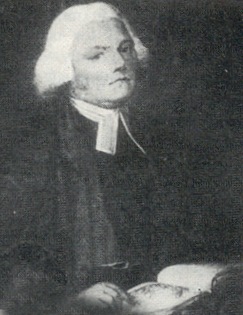<Back to Index>
- Naturalist Gilbert White, 1720
- Composer Giovanni Battista Bononcini, 1670
- 1st Prime Minister of Sweden Louis Gerhard De Geer, 1818
PAGE SPONSOR

Gilbert White (18 July 1720 – 26 June 1793) was a pioneering English naturalist and ornithologist.
White was born in his grandfather's vicarage at Selborne in Hampshire. He was educated at the Holy Ghost School and by a private tutor in Basingstoke before going to Oriel College, Oxford. He obtained his deacon's orders in 1746, being fully ordained in 1749, and subsequently held several curacies in Hampshire and Wiltshire, including Selborne's neighbouring parishes of Newton Valence and Farringdon, as well as Selborne itself on four separate occasions. In 1752 - 53 White held the office of Junior Proctor at Oxford and was Dean of Oriel. In 1757 he became non-resident perpetual curate of Moreton Pinkney in Northamptonshire. After the death of his father in 1758, White moved back into the family home at The Wakes in Selborne, which he eventually inherited in 1763. In 1784 he became curate of Selborne for the fourth time, remaining so until his death. Having studied at Oriel at the behest of his uncle, he was ineligible to be considered for the permanent living of Selborne, which was in the gift of Magdalen College.
White is best known for his The Natural History and Antiquities of Selborne (1789). This was a compilation of his letters to Thomas Pennant, the leading British zoologist of the day, and the Hon. Daines Barrington, an English barrister and another Fellow of the Royal Society. These letters contained White's discoveries about local birds, animals and plants. He believed in distinguishing birds by observation rather than by collecting specimens, and was thus one of the first people to separate the similar looking Chiffchaff, Willow Warbler and Wood Warbler by means of their song.
White is regarded by many as England's first ecologist and one of the founders of modern respect for nature. He said of the earthworm:
Earthworms, though in appearance a small and despicable link in the chain of nature, yet, if lost, would make a lamentable chasm. [...] worms seem to be the great promoters of vegetation, which would proceed but lamely without them...
White
and William Markwick collected records of the dates of emergence of
more than 400 plant and animal species, White recording in Hampshire
and Markwick in Sussex between 1768 and 1793. These data, summarised in The Natural History and Antiquities of Selborne as the earliest and latest dates for each event over the 25 year period, are among the earliest examples of modern phenology. His 1783 – 84 diary corroborates the dramatic climatic impacts of the volcanic 'Laki haze' that spread from Iceland with lethal consequences across Europe. White's frequent accounts of a tortoise inherited from his aunt in The Natural History and Antiquities of Selborne form the basis for Verlyn Klinkenborg's book, Timothy; or, Notes of an Abject Reptile (2006), as well as for Sylvia Townsend Warner's The Portrait of a Tort oise (1946). Gilbert
White's famous work has been continuously in print since its first
publication and is one of the most frequently published books in the
English language; it is available online from the Gutenberg Project. The paperback edition of The Illustrated Natural History of Selborne was last reprinted by Thames & Hudson in
2007. It was long held to be the fourth most published book in the
English language after the Bible, the works of Shakespeare, and John
Bunyan’s The Pilgrim’s Progress.
His house in Selborne,
The Wakes, now contains the Gilbert White Museum, as well as the Oates Memorial Museum, commemorating Frank and
Lawrence Oates. The
Selborne Society was founded in 1895 to perpetuate the memory of
Gilbert White. It purchased land at Perivale in West London to create
the first Bird Santuary in Britain, known as Perivale Wood. In the
1970s, Perivale Wood became a Local Nature Reserve. This was designated
by Ealing Borough Council under the National Parks and Access to the
Countryside Act 1949. It was at the instigation of a small group of young
naturalists led by Edward Dawson, with the support of Peter Edwards and
Kevin Roberts. The
Gilbert White Fellowship was founded in 1932 by Winifred Boyd Watt, a
historian and naturalist. It was based at Oxford, but was unable to
gain continued financial sponsorship. Suggestions to revive it have
been made in 2010 as part of the Selborne Society's Gilbert White
Memorial Library relocation. White is quoted by Merlyn in The Once and Future King by T.H. White. A biography of White by Richard Mabey was published by Century Hutchinson in 1986, and won the Whitbread Biography of the Year award. A documentary about White, presented by historian Michael Wood, was broadcast by BBC Four in 2006.